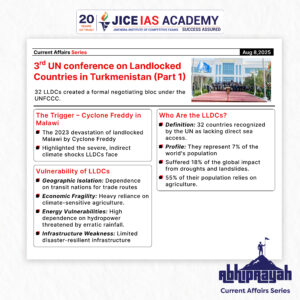UPSC CURRENT AFFAIRS – 06th April 2025
Aircraft Carriers and Strategic Power in the Indo-Pacific

Why in News?
- From March 19–22, 2025, INS Vikrant operated jointly with France’s nuclear-powered aircraft carrier Charles de Gaulle in the Arabian Sea during Exercise Varuna 2025, showcasing growing interoperability and India’s increasing maritime clout.
- This follows the successful demonstration of “twin carrier operations” by INS Vikrant and INS Vikramaditya on March 5, 2024, signifying full operationalisation of India’s indigenous aircraft carrier.
Key Highlights
- India operates two aircraft carriers:
- INS Vikramaditya: Modified Kiev-class carrier acquired from Russia.
- INS Vikrant: First indigenously built carrier, commissioned in September 2022, displaces over 40,000 tonnes.
- March 5, 2024: Both carriers conducted synchronized operations including MiG-29K fighters launching and cross-deck landings, observed by the Defence Minister.
- March 2025: INS Vikrant partnered with the French carrier strike group led by Charles de Gaulle (CDG) during Exercise Varuna, featuring Rafale-M jets, E-2 Hawkeye AWACS, and deck-based coordination.
- India is set to procure 26 Rafale-Marine aircraft to operate from these carriers, enhancing their offensive and surveillance reach.
Geopolitical Significance
The Indo-Pacific has emerged as the strategic theatre of the 21st century, witnessing intense maritime contestation and naval build-ups:
- China is rapidly expanding its blue-water naval capabilities, currently building its fourth aircraft carrier, likely to be nuclear-powered and comparable in size to U.S. supercarriers. This reflects Beijing’s ambition to project power beyond the South China Sea and challenge U.S. dominance.
- The United States continues to maintain the world’s most formidable aircraft carrier fleet, with nuclear-powered Nimitz- and Ford-class carriers and multiple Carrier Strike Groups patrolling the Indo-Pacific, particularly in the South China Sea, Western Pacific, and Persian Gulf.
Aircraft carriers, as floating airbases, are central to modern naval strategy for several reasons:
-
- Power Projection: Carriers enable a state to project combat air power thousands of kilometers from its shores without relying on foreign bases.
- Maritime Domain Awareness: Their air assets—including AWACS and drones—enhance real-time surveillance, early warning, and intelligence-gathering.
- Deterrence and Crisis Response: Carrier presence sends a strategic message, deterring hostile actions and enabling rapid humanitarian or military response in times of conflict or natural disaster.
- Securing Sea Lanes of Communication (SLOCs): With more than 90% of global trade moving by sea, carriers safeguard chokepoints like the Strait of Malacca, Bab-el-Mandeb, and Hormuz, which are vital for India’s and the world’s energy and trade flows.
For India, developing carrier capabilities and participating in exercises like Varuna reinforces its role as a net security provider and a balancing power in the Indo-Pacific, countering unilateral dominance and ensuring a rules-based maritime order.
India’s maritime doctrine, 2015
India’s maritime doctrine, as articulated in the 2015 strategy document titled “Ensuring Secure Seas: Indian Maritime Security Strategy”, outlines the core tenets of India’s evolving naval posture:
- Sea Control in the Indian Ocean Region (IOR)
India aims to maintain the ability to dominate and secure critical maritime spaces in the IOR, ensuring uninterrupted trade, energy flows, and national security.
- Deterrence and Strategic Presence in the Extended Neighbourhood
The doctrine underscores the importance of sustained presence and mission-based deployments in the Western Pacific, Southern IOR, and areas of strategic interest to deter adversarial activities and reassure partners. - Cooperative Security through Multilateral Engagements
India supports a rules-based maritime order and promotes maritime stability through joint exercises, HADR missions, and naval diplomacy with like-minded nations (e.g., Exercise Malabar, Varuna, MILAN).
This doctrine aligns with India’s vision of emerging as a “Net Security Provider” in the Indo-Pacific—projecting stability, safeguarding regional commons, and supporting partners in need.
India–France Defence Cooperation
India and France share a robust strategic partnership rooted in defence, technology, and a shared commitment to a rules-based Indo-Pacific order. Their defence cooperation spans multiple domains:
- Technology Sharing
France has been a key partner in naval propulsion systems, advanced radar and sonar technologies, and weapon systems integration. This aligns with India’s vision of defence indigenisation under Atmanirbhar Bharat. - Submarine Collaboration – Project 75
The Scorpène-class submarines, being built at Mazagon Dock Shipbuilders Limited (MDL) under technology transfer from France’s Naval Group, represent successful Make in India defence production. Six submarines have already been inducted or are in final stages. - Potential collaboration on Rafale-M support ecosystems is also under consideration.
Strategic Convergence in the Indo-Pacific
France is among the few European powers with a permanent presence in the Indo-Pacific, and its strategy aligns closely with India’s Act East Policy and Indo-Pacific Oceans Initiative (IPOI). Both nations support:
- Freedom of navigation
- Multilateral cooperation through forums like Indian Ocean Naval Symposium (IONS) and EU–India Maritime Dialogue
- Infrastructure and climate-resilient connectivity in Indian Ocean island nations and Africa
This partnership reflects a shift from a buyer-seller relationship to one of trusted strategic collaboration based on mutual interests, particularly in a rapidly evolving Indo-Pacific security landscape.
Conclusion
Aircraft carriers remain potent symbols of national power and maritime dominance. For India, operationalising twin-carrier operations, building indigenous platforms, and engaging with partners like France marks a leap toward becoming a blue water navy. In a region marked by shifting power dynamics and growing assertiveness, India’s carrier-led capabilities are essential for strategic deterrence, regional stability, and maritime leadership in the Indo-Pacific.

3rd UN conference on landlocked countries
UPSC CURRENT AFFAIRS – 08th August 2025 Home / 3rd UN conference on landlocked countries Why in News? At the

Issue of soapstone mining in Uttarakhand’s Bageshwar
UPSC CURRENT AFFAIRS – 08th August 2025 Home / Issue of soapstone mining in Uttarakhand’s Bageshwar Why in News? Unregulated

Groundwater Pollution in India – A Silent Public Health Emergency
UPSC CURRENT AFFAIRS – 08th August 2025 Home / Groundwater Pollution in India – A Silent Public Health Emergency Why

Universal banking- need and impact
UPSC CURRENT AFFAIRS – 08th August 2025 Home / Universal banking- need and impact Why in News? The Reserve Bank

India’s “Goldilocks” Economy: A Critical Appraisal
UPSC CURRENT AFFAIRS – 08th August 2025 Home / India’s “Goldilocks” Economy: A Critical Appraisal Why in News? The Finance

U.S.-India Trade Dispute: Trump’s 50% Tariffs and India’s Oil Imports from Russia
UPSC CURRENT AFFAIRS – 07th August 2025 Home / U.S.-India Trade Dispute: Trump’s 50% Tariffs and India’s Oil Imports from

Eco-Friendly Solution to Teak Pest Crisis: KFRI’s HpNPV Technology
UPSC CURRENT AFFAIRS – 07th August 2025 Home / Eco-Friendly Solution to Teak Pest Crisis: KFRI’s HpNPV Technology Why in

New Species of Non-Venomous Rain Snake Discovered in Mizoram
UPSC CURRENT AFFAIRS – 07th August 2025 Home / New Species of Non-Venomous Rain Snake Discovered in Mizoram Why in


